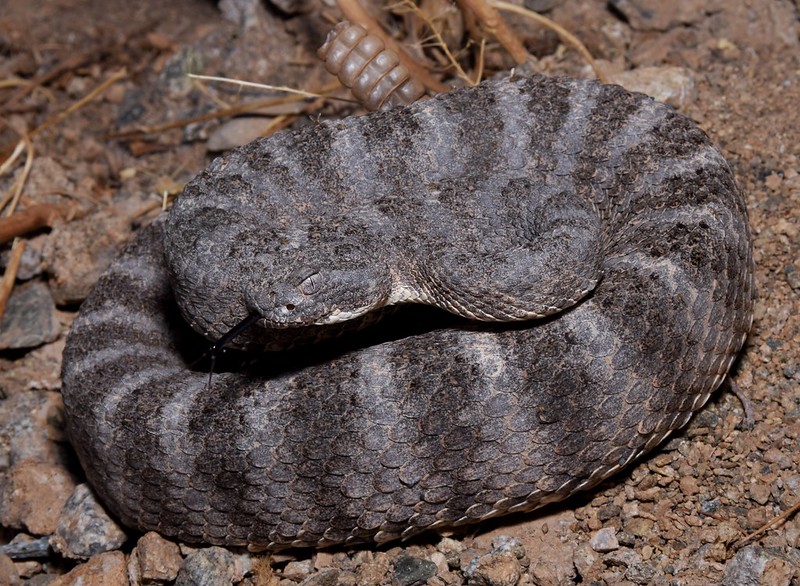Tiger Rattlesnake Facts
- This magnificent creation of Nature and evolution most frequently goes by its common name of the Tiger Rattlesnake. Professionals, however, more commonly refer to the creature by its formal, scientific name. That’s the term of Crotalus tigris.
- Perhaps the most noteworthy fact about the reptile remains the level of danger it represents. That holds true due to the fact that it represents the most dangerous of known varieties of rattlesnake. This level of danger occurs regardless of size.
- The quantity of venom injected also equals much less than that of similar species. Yet, its the nature of the toxin that makes it so perilous. That’s because the venom contains a powerful mix of neurotoxins and mycotoxins, often leading to muscle death.
- Unfortunately for it, though, the range of the species is restricted. Even within that range, its own nature serves as a limiting factor to its potential spread. That occurs due to the fact that its habitat requirements restrict its population to specific regions.
- Despite inhabiting such a restricted range, however, its numbers remain stable. The IUCN, therefore, lists the Tiger Rattlesnake as Least Concern on its Red List. Nevertheless, given the nature of its needs, it remains vulnerable to climate change.
Related Articles
Tiger Rattlesnake Physical Description
The Tiger Rattlesnake classifies as a type of pit viper. It also qualifies as a smaller than average one. Like many species of reptiles, though, it displays the trait of sexual dimorphism. In its case, the males typically attain a slightly larger size than that of the females.
Neither gender attains an impressive physical size, however. Lengths vary significantly between individuals, though. Adults average between 18 – 36 in (46 – 92 cm) in length. The average length is about 24 in (61 cm). Weights also rarely exceed 1 lb ( 0.45 kg).
The most distinguishing physical feature of the Tiger Rattlesnake is the head. This develops in a highly rectangular shape. It also forms quite small in proportion to body length. The rattle on its tail further develops relatively much larger than others, though.
Its basic coloring also varies greatly among individuals. Most present combinations of an orange-brown or bluish gray. Black bars also show across the body, thus the common name. Like all pit vipers, individuals also possess heat-sensing organs on each side of the head.
- Kingdom: Animalia
- Phylum: Chordata
- Class: Reptilia
- Order: Squamata
- Family: Viperidae
- Genus: Crotalus
- Species: C. tigris
Tiger Rattlesnake Distribution, Habitat, and Ecology
Regrettably, the astonishing Tiger Rattlesnake evolved as solely endemic to a moderately small region of the globe. It’s also a region well known for its abundance of natural marvels, though. That’s because it’s endemic to specific portions of the continent of North America.
More specifically, the tantalizing reptile appears only in the region of the state of Arizona, in the United States, and southern Mexico. Even more specifically, though, within that limited range, the snakes roam at altitudes ranging from sea level to 4,806 ft (1,465 m).
The small but powerful reptile further inhabits an environment considered extremely harsh for most species. That’s due to the fact that it usually inhabits regions of rocky desert canyons, bajadas, and foothills. This highly adapted species also remains mainly terrestrial.
Nevertheless, some individuals do occasionally diverge from this typical pattern of behavior. On occasional, some specimens choose to perch in low vegetation. Its periods of activity also vary somewhat, according to the seasons, having adapted to its environment.
Just as all other known snakes, it evolved as a carnivore. Given its size, individuals primarily prey on a variety of small mammals. Yet, it distinguishes itself in another manner. That’s because, unlike most snakes, it hunts by both ambush and active stalking equally.
Considering its level of lethality, its own predators remain few. But the few it does face includes hawks and eagles. By nature, the Tiger Rattlesnake can be easily annoyed and remains quite aggressive. The major threat it faces is human expansion into its territory.
Species Sharing Its Range
Check out our other articles on 4 Remarkably Unique Rabbits, Barreleye Fish, Seven Rila Lakes, Icicle Mushroom, Red Crested Tree Rat, Gooty Sapphire Tarantula, Adelie Penguin

